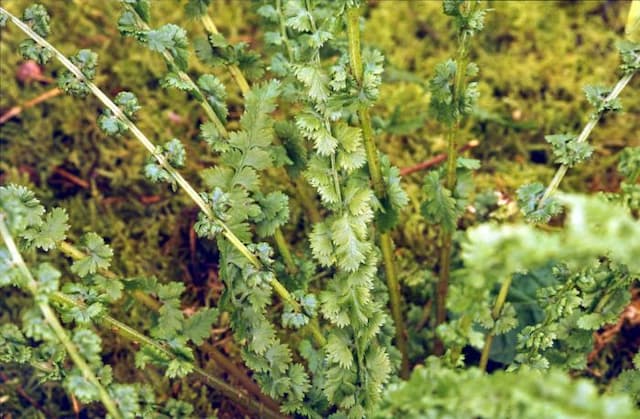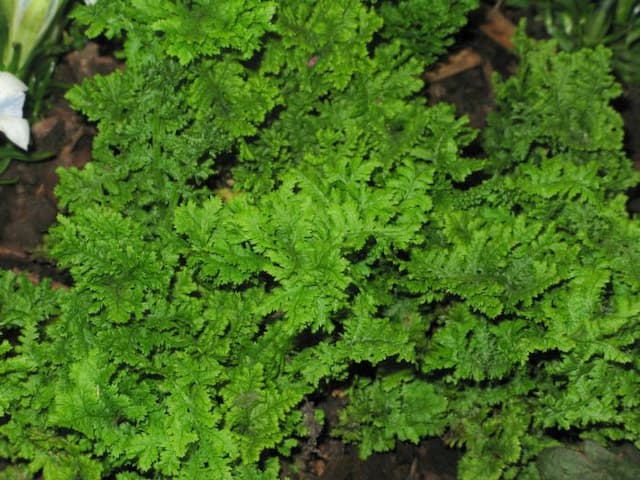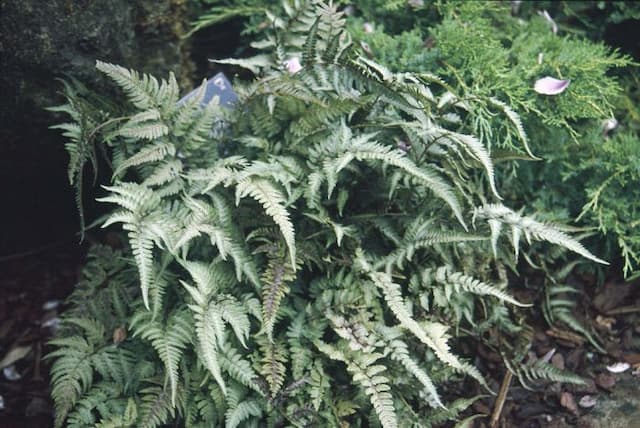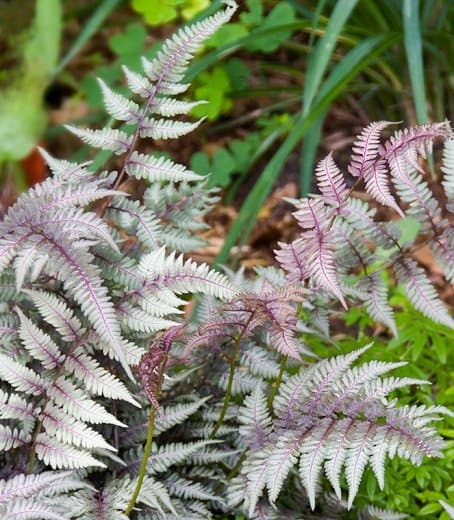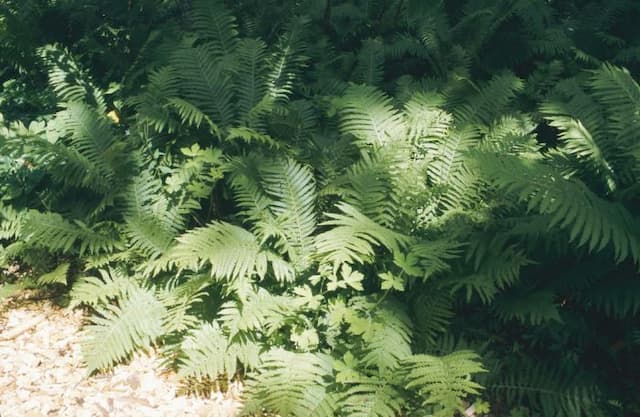Japanese Painted Fern Athyrium niponicum var. pictum 'Silver Falls'

ABOUT
The Japanese painted fern, known as 'Silver Falls', is a strikingly beautiful fern with delicate fronds that exhibit a blend of silver, green, and red-purple hues. The fronds have a shimmering silver sheen, which is highlighted by the contrasting dark maroon midribs running up the center of each leaflet. The foliage is intricately patterned, with soft-textured leaflets that gracefully arch and overlap, creating a dense and lacy appearance. The silver color of the fronds is more pronounced toward the center, while the edges have a subtle green shade, giving the overall impression of a silvery waterfall cascading down. This ornamental fern brings an ethereal quality to shaded gardens, with its variegated leaves sparking visual interest and adding a cool, metallic accent among other shade-loving plants. The 'Silver Falls' variety of the Japanese painted fern is appreciated for its unique coloration and ability to create a tranquil, woodland-feel atmosphere in landscaping.
About this plant
 Names
NamesFamily
Dryopteridaceae
Synonyms
Japanese Painted Fern, Silver Falls Japanese Fern
Common names
Athyrium goeringianum 'Silver Falls', Athyrium niponicum 'Silver Falls', Athyrium niponicum var. pictum 'Metallicum', Athyrium niponicum 'Pictum', Athyrium nipponicum 'Ursulas Red'.
 Toxicity
ToxicityTo humans
The Japanese painted fern (Athyrium niponicum var. pictum 'Silver Falls') is not known to be toxic to humans. There are no common symptoms of poisoning because it is generally considered safe and non-toxic. Therefore, ingesting parts of this plant is not expected to have harmful consequences for humans based on the information available up to the knowledge cutoff date.
To pets
The Japanese painted fern is also not known to be toxic to pets. Hence, it should not cause any symptoms of poisoning in animals such as dogs and cats. Ingesting the fern is not expected to lead to adverse health effects in pets. However, it is always a good practice to monitor pets around plants and discourage them from eating ornamental foliage to avoid any potential gastrointestinal upset.
 Characteristics
CharacteristicsLife cycle
Perennials
Foliage type
Deciduous
Color of leaves
Variegated
Height
1 foot 2-3 feet (30-90 cm)
Spread
1 foot 2-3 feet (30-90 cm)
Plant type
Fern
Hardiness zones
4-9
Native area
Japan
Benefits
 General Benefits
General Benefits- Visual Appeal: Offers ornamental value with its metallic silver-gray foliage accented by hints of red and blue.
- Low Maintenance: Requires minimal care once established, making it a user-friendly option for gardeners of all levels.
- Shade Tolerance: Thrives in shade, making it ideal for gardens with limited sunlight.
- Drought Resistance: Can tolerate periods of dryness once established, reducing the need for frequent watering.
- Cold Hardy: Resistant to cold temperatures, which enables it to survive in a variety of climates.
- Soil Versatility: Adapts to a range of soil conditions from moist to moderately dry, provided it is well-drained.
- Non-Invasive: Unlike some fern species, it doesn't tend to spread uncontrolled, which helps to maintain garden design integrity.
- Wildlife Support: Can provide habitat for certain species of wildlife such as birds and beneficial insects.
- Texture Contrast: Adds a fine, delicate texture to the garden, contrasting well with broader-leaf plants.
- Seasonal Interest: Displays subtle changes in color and texture throughout the seasons, adding year-round interest to the landscape.
 Medical Properties
Medical PropertiesThis plant is not used for medical purposes.
 Air-purifying Qualities
Air-purifying QualitiesThis plant is not specifically known for air purifying qualities.
 Other Uses
Other Uses- Japanese Painted Fern 'Silver Falls' can be used in fantasy or fairy gardens as its delicate foliage adds a touch of whimsy and enchantment to these miniature landscapes.
- It can be featured in floral arrangements, especially woodland-themed bouquets, to provide a delicate texture and silvery-green accent.
- As a natural dye, the fronds of Japanese Painted Fern may be used to impart a green hue to textiles or paper when processed properly.
- The fern's presence can reduce soil erosion in gardens by providing a network of roots that help to stabilize the soil on sloping grounds.
- Japanese Painted Fern can be used as a backdrop in vivariums or terrariums, creating a lush, green environment for amphibians and reptiles.
- This fern can serve as a subtle privacy screen when planted densely in a shaded garden, offering a gentle boundary without a heavy or intrusive appearance.
- As an art subject, the intricate fronds and variegated colors of Japanese Painted Fern can inspire botanical illustrations or nature-inspired designs.
- In shaded water gardens or near ponds, the fern can add foliage interest without overshadowing water features or aquatic plants.
- It can be utilized in sensory gardens for its unique texture, providing a visual and tactile experience for visitors to enjoy.
- During the Halloween season, the dark, silvery fronds can be incorporated into spooky-themed garden displays for a natural, ghostly effect.
Interesting Facts
 Feng Shui
Feng ShuiThe Japanese Painted Fern is not used in Feng Shui practice.
 Zodiac Sign Compitability
Zodiac Sign CompitabilityThe Japanese Painted Fern is not used in astrology practice.
 Plant Symbolism
Plant Symbolism- Elegance - The Japanese Painted Fern 'Silver Falls', with its graceful silver-grey fronds, is often associated with elegance and a delicate aesthetic.
- Serenity - The soft, flowing nature of its foliage tends to evoke a sense of calm and tranquility, making it symbolic of peace and serenity.
- New Beginnings - Ferns in general are known to symbolize new beginnings or hope, as they are one of the first plants to grow back after a forest fire, and 'Silver Falls' is no exception.
- Privacy and Solitude - In a garden setting, ferns like 'Silver Falls' can create a peaceful, secluded space, symbolizing the value of privacy and quiet reflection.
- Endurance - Despite their delicate appearance, ferns are hardy plants that can thrive in challenging conditions, making them a symbol of resilience and endurance.
 Water
WaterThe Japanese Painted Fern should be kept moist but not waterlogged. Water the plant thoroughly when the top inch of soil feels dry to the touch, roughly once a week, depending on environmental conditions. Ensure the fern receives about half a gallon of water at each watering, allowing the water to seep deep into the soil to encourage root growth. During hot, dry periods, watering frequency should increase to maintain consistent soil moisture but always check the soil moisture level before watering to avoid overwatering.
 Light
LightJapanese Painted Fern thrives best in partial to full shade, avoiding direct afternoon sun which can scorch its delicate fronds. An ideal spot would be under a canopy of trees or on the north side of a building where it can receive filtered sunlight or gentle morning sun. This fern favors a bright location without exposure to harsh sun rays.
 Temperature
TemperatureThe Japanese Painted Fern prefers cool to moderate temperatures, thriving ideally between 55 to 75°F. It can tolerate temperatures down to 20°F, but frost can damage the fronds. Make sure to protect it from extreme heat as temperatures consistently above 85°F might stress the plant.
 Pruning
PruningPruning the Japanese Painted Fern is mainly to remove dead or damaged fronds to maintain a tidy appearance and encourage healthy growth. Prune in early spring before new growth starts, cutting back any old fronds to the ground level. This encourages fresh, new fronds to emerge and keeps the plant looking its best.
 Cleaning
CleaningAs needed
 Soil
SoilThe Japanese Painted Fern, 'Silver Falls', thrives in a well-draining soil rich in organic matter with a pH of 4.0 to 7.0. The best soil mix can be achieved by combining garden loam, peat moss, and perlite or coarse sand to ensure proper drainage and aeration. Regular incorporation of compost or well-rotted manure will enrich the soil and support its growth.
 Repotting
RepottingThe Japanese Painted Fern 'Silver Falls' typically requires repotting every 2 to 3 years. It's best to repot when the plant becomes root-bound or when the soil quality deteriorates, ensuring the health and vigor of the fern.
 Humidity & Misting
Humidity & MistingJapanese Painted Fern 'Silver Falls' prefers a high humidity environment, ideally between 60% and 80%. This fern will benefit from being placed in a naturally humid area or by using humidity trays to maintain adequate moisture in the air around the plant.
 Suitable locations
Suitable locationsIndoor
Provide indirect light, keep soil moist, and ensure high humidity.
Outdoor
Plant in shade, maintain moist soil, and protect from wind.
Hardiness zone
4-9 USDA
 Life cycle
Life cycleJapanese painted fern 'Silver Falls' starts its life cycle from spores, which germinate to form a prothallus—a small, gametophyte structure that produces both sperm and eggs. When conditions are right, typically in moist and shaded environments, fertilization occurs on the prothallus, leading to the growth of a new sporophyte—the leafy fern plant. The young fern grows through a juvenile phase, developing its characteristic silver and burgundy fronds over time. As the fern matures, it reaches its reproductive stage, where sori develop on the undersides of the fronds, containing new spores. Once matured, the spores are released into the environment to start the cycle anew. This perennial plant will go through a dormancy period during adverse conditions, typically in colder climates, and will regrow from its root system the following season.
 Propogation
PropogationPropogation time
Spring-Early Summer
Propogation: The Japanese Painted Fern, Athyrium niponicum var. pictum 'Silver Falls', is typically propagated by division, a simple and effective method widely used by gardeners. The best time to divide Japanese Painted Ferns is in the spring as new growth begins to appear, providing the plant with a full growing season to establish itself. To propagate by division, carefully lift the fern with a shovel, ensuring that you maintain a good portion of the root system. Once lifted, you can use a sharp knife or garden spade to divide the root clump into smaller sections, each with several fronds and a healthy amount of roots. Replant the divisions immediately at the same soil depth as the original plant, spacing them about 12 to 18 inches apart (30 to 45 cm), and water them thoroughly to help establish the new plants.
